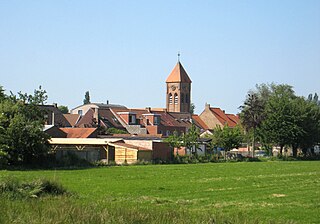
The Battle of Moerbrugge was a three-day battle during the Liberation of Belgium.

The 4th Infantry Division was a regular infantry division of the British Army with a very long history, seeing active service in the Peninsular War and Waterloo Campaign, the Crimean and Boer Wars and both World Wars. It was disbanded after the Second World War and reformed in the 1950s as an armoured formation before being disbanded and reformed again and finally disbanded on 1 January 2012.

The Calgary Highlanders is a Canadian Army Primary Reserve infantry regiment, headquartered at Mewata Armouries in Calgary, Alberta, Canada. The regiment is a part-time reserve unit, under the command of 41 Canadian Brigade Group, itself part of 3rd Canadian Division, one of four region-based Canadian Army divisions. The regiment is one of only two regiments in the Canadian Forces to wear an honorary distinction on their uniform, commemorating the counterattack at Kitcheners' Wood. On 9 January 2015, the regiment was recognized with the Canadian Forces' Unit Commendation for outstanding contributions to the war in Afghanistan.

The 2nd Canadian Division is a formation of the Canadian Army in the province of Quebec, Canada. The present command was created 2013 when Land Force Quebec Area was re-designated. The main unit housed in this division is the Royal 22nd Regiment based at CFB Valcartier near Quebec City, which is the biggest regiment in the Canadian Army.

The 4th Canadian Division is a formation of the Canadian Army. The division was first created as a formation of the Canadian Corps during the First World War. During the Second World War the division was reactivated as the 4th Canadian Infantry Division in 1941 and then converted to armour and redesignated as the 4th Canadian (Armoured) Division. Beginning in 1916 the division adopted a distinctive green-coloured formation patch as its insignia. In 2013 it was announced that Land Force Central Area would be redesignated 4th Canadian Division. It is currently responsible for Canadian Army operations in the Canadian province of Ontario and is headquartered at Denison Armoury in Toronto.

The 5th Canadian Division is a formation of the Canadian Army responsible for the command and mobilization of most army units in the provinces of New Brunswick, Nova Scotia, Prince Edward Island and Newfoundland and Labrador; as well as some units in Kingston, Ontario. The division is recognized by the distinctive maroon patch worn on the sleeve of its soldiers.

The Argyll and Sutherland Highlanders (Princess Louise's) is a light infantry company (designated as Balaklava Company, 5th Battalion, Royal Regiment of Scotland) and was a line infantry regiment of the British Army that existed from 1881 until amalgamation into the Royal Regiment of Scotland on 28 March 2006.
North-West Europe 1944–1945 is a battle honour earned by regiments of the British Commonwealth forces during the Second World War that took part in the actions of the northern part of the war's Western Front. The battle honour North-West Europe is suffixed with the year, or years, in which the awarded unit took part in the action.

The Argyll and Sutherland Highlanders of Canada (Princess Louise's), or A & SH of C, is a Primary Reserve Highland infantry regiment of the Canadian Forces, based at John W. Foote VC Armoury in Hamilton, Ontario.

The 11th Armoured Division was an armoured division of the British Army which was created in March 1941 during the Second World War. The division was formed in response to the unanticipated success of the German panzer divisions. The 11th Armoured was responsible for several major victories in the Battle of Normandy from in the summer of 1944, shortly after the Normandy landings, and it participated in the Allied advance from Paris to the Rhine, the Rhine crossing in March 1945. It was disbanded in January 1946 and reformed towards the end of 1950. In 1956, it was converted into the 4th Infantry Division.

The 8th Armoured Brigade was an armoured brigade of the British Army formed in August 1941, during the Second World War and active until 1956. The brigade was formed by the renaming of 6th Cavalry Brigade, when the 1st Cavalry Division based in Palestine converted from a motorised formation to an armoured unit, becoming 10th Armoured Division.

The 29th Infantry Brigade was an infantry brigade unit of the British Army. It was originally raised in 1914 and saw service during the First and Second World Wars and the Korean War.

Operation Jupiter was an offensive by VIII Corps of the British Second Army from 10 to 11 July 1944. The operation took place during the Battle of Normandy in the Second World War. The objective of the 43rd (Wessex) Infantry Division was to capture the villages of Baron-sur-Odon and Fontaine-Étoupefour and Chateau de Fontaine-Étoupefour, and to recapture Hill 112. An attached brigade of the 15th (Scottish) Infantry Division would take Éterville, Maltot and the ground up to the River Orne and then the tanks of the 4th Armoured Brigade, supported by infantry, would advance through the captured ground and secure several villages to the west of the River Orne. It was hoped that the initial objectives could be captured by 9:00 a.m., after which the 4th Armoured Brigade would exploit the success.

The South Alberta Regiment (SAR) was a regiment of the Canadian Army that existed from 1924 to 1954. Originally infantry, in February 1942 it became an armoured unit. During World War II the Regiment fought from July 1944 to May 1945 in France, Belgium, the Netherlands, and Germany.
The 44th Infantry Brigade was an infantry brigade of the British Army that saw active service in both the First and the Second World Wars, and served with the 15th (Scottish) Infantry Division.
The 46th Infantry Brigade was an infantry brigade of the British Army that saw active service in both the First and the Second World Wars with the 15th (Scottish) Infantry Division.
227th Brigade was an infantry formation of the British Army formed for Home Service under various short-lived titles in the First and the Second World Wars. Later it was upgraded to a field formation composed of Scottish troops, and saw heavy fighting in the Normandy and North West Europe Campaign.

The Cape Breton Highlanders is an infantry regiment of the Canadian Army. It was established in 1871, merged into The Nova Scotia Highlanders in 1954, and re-established as a distinct regiment in 2011. It is part of the 5th Canadian Division's 36 Canadian Brigade Group and is headquartered at Sydney, Nova Scotia.

The razing of Friesoythe was the destruction of the town of Friesoythe in Lower Saxony on 14 April 1945, during the Western Allies' invasion of Germany towards the end of World War II in Europe. The 4th Canadian (Armoured) Division attacked the German-held town of Friesoythe, and one of its battalions, The Argyll and Sutherland Highlanders of Canada, captured it.
This is a Bibliography of World War military units and formations. It aims to include historical sources and literature about specific unit formations of World War II, such as fronts/army groups, field armies, army corps, divisions, brigades, regiments, battalions, and companies. It also includes air force formations, such as air divisions, air groups, air wings, air squadrons and air force flights. Furthermore, it includes naval formations, such as naval divisions, naval squadrons, flotillas, carrier battle groups, naval task forces and naval fleets.















